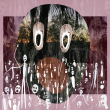AustLit
-
What is the Australian Gothic?
You can probably bring some texts to mind: Barbara Baynton's Bush Studies, Joan Lindsay's Picnic at Hanging Rock (and Peter Weir's film), Kenneth Cook's Wake in Fright (and Ted Kotcheff's film), Elizabeth Jolley's The Well, perhaps even Mad Max or something much more modern, such as Kathy George's Sargasso or Karen Manton's The Curlew's Eye.
In this project, AustLit aims to see how far the influence of Australian Gothic spreads in Australian writing, both contemporary and past.
-
With this research project, AustLit is working with some core questions in mind.
What makes the Gothic Australian?
How broadly has it influenced Australian story-telling?
How does it vary from city to city, region to region, state to state?
How can it be harnessed by First Nations writers to critique the colonial state—or is it inherently colonial?
To begin at the beginning.
Broadly speaking, Gothic works:
... explore the return of what is repressed, concealed and unspoken, as a sinister or traumatic past resurfaces to haunt the present
... highlight the hidden and monstrous aspects of human nature
... toy with Freud’s idea of the uncanny, when the familiar assumes an unsettling strangeness; foreground the taboo
... and question socio-cultural landscapes of the past and present, including normative morals, ideologies and practices.
In defining the colonial Australian Gothic, Ken Gelder focuses on literary works that explore the unsettling encounters of European colonists with a foreign landscape that does not abide by British laws of nature. For Gelder, the Australian landscape is inherently Gothic. It unites feelings of desolation in endless wide-open spaces with the claustrophobia of isolation. The Gothic Australian landscape inspires anxiety and dread about the coloniser’s personal safety, but also about the success of their colonial project. The outback town is associated with degeneracy, violence, and aggressive misogyny and racism that challenge ideas of colonial progress. Gelder also points to recurring themes of the ghostly return of missing explorers from the desert, children becoming lost in the bush, the bunyip, and of the Australian homestead as an degenerate version of the stately British home.
-
Gerry Turcotte similarly argues that colonial Australian Gothic texts depict the experiences of British explorers uprooted and placed in a threatening and unfamiliar landscape, where the laws of British nature and society are void. In colonial Australian Gothic fiction, the colonist is placed in an alien environment where they are victimised by frightening flora and fauna, escaped convicts, bush rangers and the Indigenous population that they are violently displacing.
Stephen Carleton emphasises that the Australian Gothic deals with the anxieties associated with Australia’s isolation from the 'civilising' influence of Britain; Australia appears as a place of lawlessness in comparison to metropolitan Britain. However, the Gothic also allows us to tell unspoken stories that engage with Australia's violent history, including stories of the Stolen Generations and the First Nations people who were and continue to be affected by genocide and dispossession at the hands of the colonial regime. Carleton refers to essential elements of the Australian Gothic being the return of 'hauntings' from this shameful and violent colonial past, a wild and alien landscape, and gendered violence in isolated rural communities.
You might be interested in...







